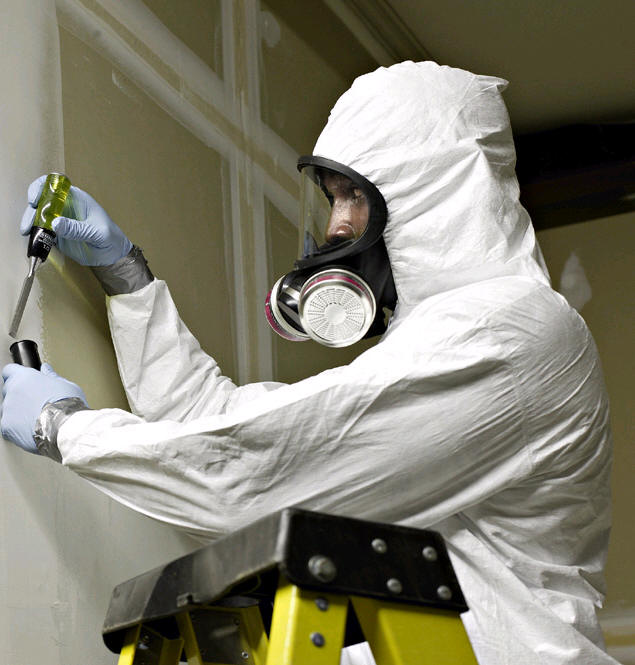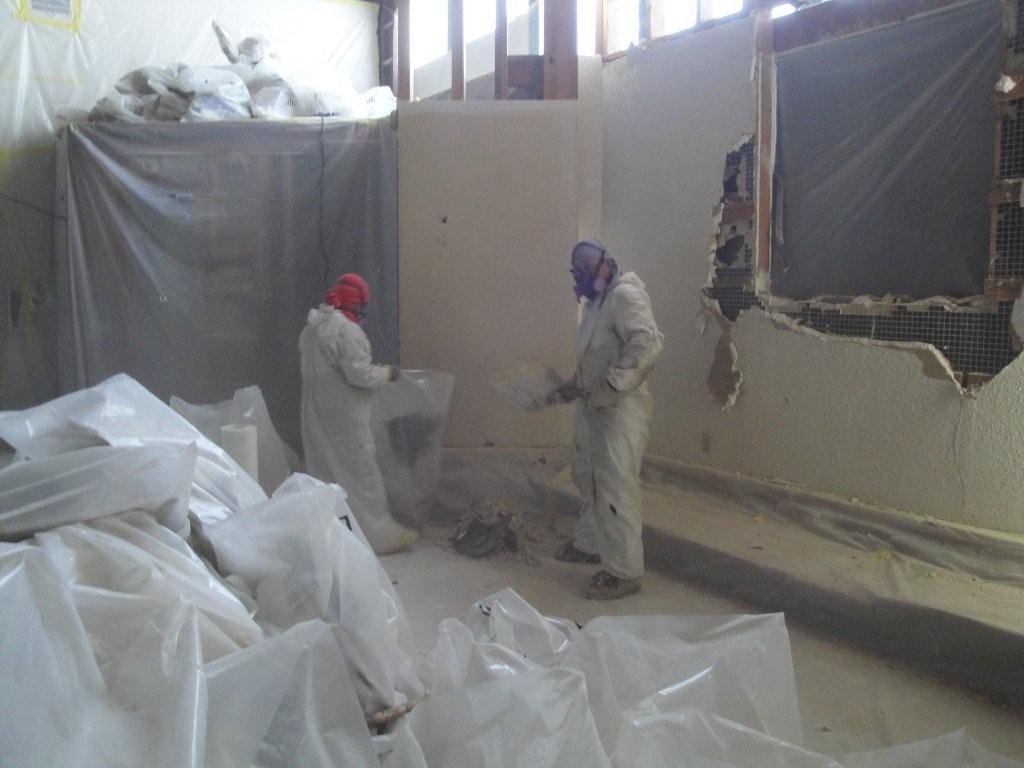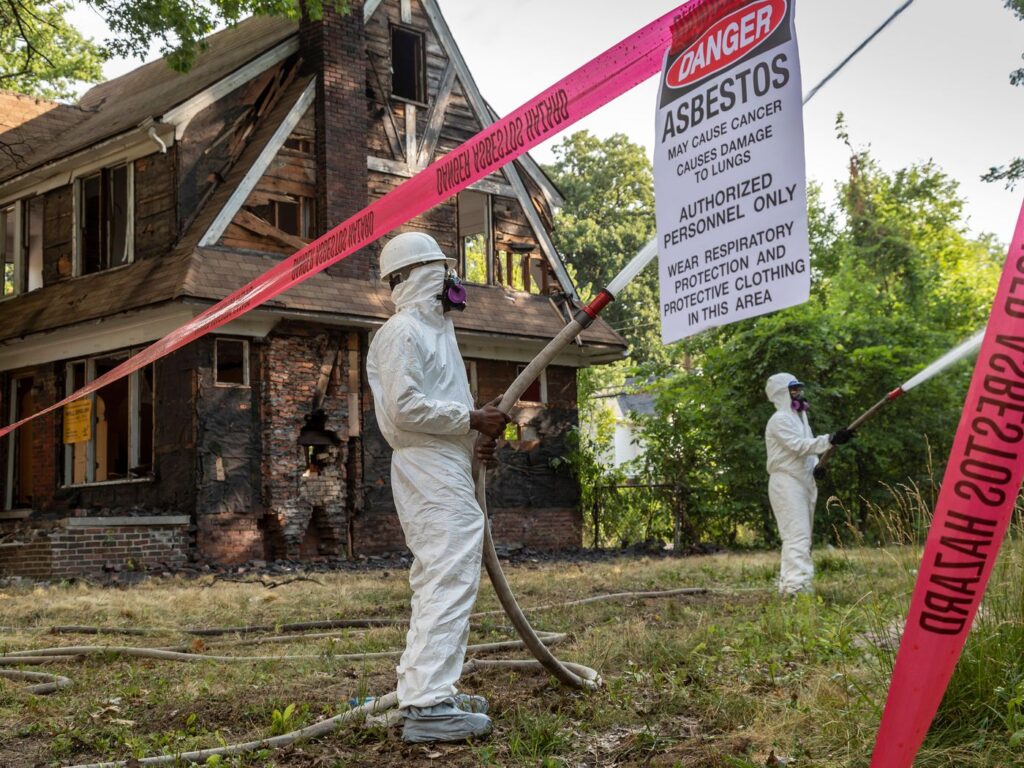Asbestos is a very hazardous material that was common used in many building materials, including plaster. Asbestos plaster has been used in the construction of many residential houses, as well as office buildings, warehouse, schools, universities and churches. Despite the serious health problems it causes, asbestos is still legal in the United States and Canada. However, most building materials that contain asbestos were produced between 1940 and 1990. Asbestos in plaster is far less common than it used to be, but can still be found in many older residential and commercial buildings today.
Identifying Asbestos Plaster

There are 3 common varieties of asbestos plaster: cement plaster, gypsum (AKA Plaster-of-Paris), and lime plaster (which is mostly used in artistic sculpture).
Asbestos is one of the best fire resistant materials in the world, and when asbestos is combined with plaster compounds it produces excellent fire resistant and heat resistant walls and ceilings. Up until the late 1980s, fire-rated walls were commonly produced with asbestos and plaster mixes. Plaster only has to be comprised of 1% asbestos to be considered an asbestos containing material (ACM) and therefore a health hazard.
Older brands of cement may have asbestos fibers in the plaster mix. In most cases, just performing a visual inspection won’t be adequate to determine whether or not any plaster has asbestos in it. Usually asbestos was only added to walls that were fire rated, such as elevator shaft walls and the walls in commercial buildings. Most houses don’t have asbestos plaster in them. To ensure everyone’s safety, if you know a wall is fire rated and was built before 1990, you should assume that it contains asbestos and get a sample of the plaster tested immediately.
Which Brands of Plaster Contain Asbestos?
There is no comprehensive list of brands of plaster that contain asbestos. However, here is a list of some of the most common plaster brands and product names that have been proven to contain asbestos:
- W.R. Grace produced asbestos plaster between 1945 and 1972
- National Gypsum produced various varieties of their “Gold Bond” brand of plaster between 1942 and 1972 which contains asbestos
- Georgia-Pacific “Acoustical” and “Patching” plaster made from 1950 to 1976 contains asbestos
- United States Gypsum plaster produced between the years 1920 to 1975 contains asbestos
- Synkoloid plaster made between 1950 and 1976 contains asbestos
- Keene plaster made from 1963 to 1971 contains asbestos
Unless records were kept of a building’s construction and renovation work on a building, it’s unlikely that you’ll be able to determine what brand of plaster is in any building without a laboratory test.
Asbestos plaster is most dangerous when it is damaged. Damaged asbestos plaster is known as “friable asbestos”, which means the material can easily break and crumble, releasing asbestos fibers into the atmosphere. You should assume that any older damaged plaster in fire-rated walls contains asbestos until a sample has been tested.

How to Test Plaster for Asbestos
WARNING: Do not attempt this unless you are an experienced professional!
Before going near any plaster that potentially contains asbestos, ensure you are wearing OSHA-approved protective clothing, gloves, goggles, and a respirator. Seal the area off to prevent anyone from entering the area.
- Wet the surface of the area you are going to take a sample with water and a small amount of detergent before touching it.
- Cut a small square of plaster out of the wall or ceiling (about 1 – 1½ inches). Make sure you cut through the entire depth of the plaster.
- Place the sample in a thick airtight plastic bag.
- Label the sample with the date and the location of where the sample was taken.
- Send the sample to an accredited asbestos testing lab along with all the information they require (which can usually be done online or sent with the sample). An asbestos sample test usually costs between $20 and $50 per sample, not including shipping.
- You should receive the results of the test in a few weeks, if not sooner.
Be on the Lookout for Other Asbestos Building Materials
Asbestos linoleum, asbestos cement pipes, asbestos pipe insulation, and asbestos roof tiles are all common ACMs in older buildings. Before starting any renovation, construction or demolition work, make sure the entire interior and exterior of the building you will be working on is given a complete asbestos survey. Samples of every material you suspect contain asbestos should be analyzed at an NIST accredited asbestos testing lab.

Asbestos was so widely used because of it’s superior resistance to heat and flames and also because it was a relatively low cost material. Asbestos fibers are practically indestructible; they are impervious to extreme heat and most chemicals, and don’t evaporate into the air. They are smaller than blood cells and can easily be breathed in without being aware of it. Once inside the lungs, they can cause irreversible lung damage and even lung cancer decades after they first entered the lungs.
Asbestos training courses are available online to provide more extensive information about the health hazards of asbestos, how to identify asbestos in building materials, how to perform a full asbestos inspection of any building, steps to take if you encounter asbestos containing materials, how to avoid exposure, and information about the two most common asbestos-related lung diseases: asbestosis and mesothelioma).
